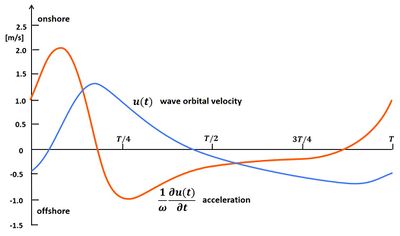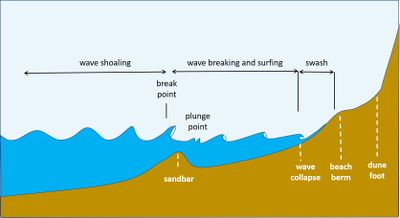Nearshore sandbars
It is recommended to read this article in conjunction with the article Shoreface profile.
Contents
Introduction
Nearshore sandbars, also called breaker bars, are a common feature of the surf zone of sandy coasts worldwide. They are the result of the dynamic interaction between the shape of the coastal profile and the transformation of waves as they propagate onshore; at the same time they are an important agent in this interaction[1]. Their presence promotes the breaking of waves further away from the shoreline; they thus reduce the wave forces exerted directly on shore[2]. The cartoon of Fig. 1 shows a typical example of the transformation and breaking of incident waves in the nearshore zone.
Bar formation
The process of bar formation is still a topic of research. It has been suggested that bar formation is related to the prevalence of onshore sand transport by incident waves before breaking and the prevalence of offshore transport after breaking[3]. Because there is no prevalence in an equilibrium situation, this must be understood as follows. A small positive perturbation of the equilibrium seabed profile (small hump) in the shoaling zone (i.e. before breaking) will migrate in onshore direction, whereas a small positive perturbation in the surf zone (i.e. after breaking) will migrate in offshore direction for sufficiently large waves[4][5]. Onshore transport prior to breaking is mainly due to the interaction of the shoaling wave with the seabed that generates higher velocities and stronger acceleration of onshore wave orbital motion compared to offshore wave orbital motion[6][7] (Fig. 2). Offshore transport is mainly due to wave breaking that produces strong turbulence and uplift of sand from the seabed that is transported seaward by so-called undertow (the return flow compensating for the onshore Stokes' mass transport)[8][9][10]. See Shoreface profile for more explanations.
 Fig. 2. Onshore-offshore asymmetry of the wave orbital velocity and acceleration in the shoaling zone. The maximum onshore orbital velocity in the wave crest phase is substantially larger than the maximum offshore orbital velocity in the wave trough phase (sometimes called positive skewness). The acceleration of offshore to onshore wave orbital velocities is also substantially larger than the acceleration in the opposite direction (sometimes called positive asymmetry). In most cases this will induce net onshore sand transport, although in some cases the opposite may also happen (see Sediment transport formulas for the coastal environment). |
 Fig. 3. Cross-shore depth profiles of the surf zone at Skallingen [11] (Denmark) and Egmond [12] (Netherlands) showing systems of multiple nearshore bars at different years. For both, 0 m depth corresponds approximately to mean sea level. At Skallingen the bar crests move in onshore direction, whereas at Egmond the bar crests move in offshore direction. At Egmond, the outer bar decays at the seaward limit of the surf zone at 8 m depth. Both coasts are storm-dominated. Symbols: median grain size [math]d_{50}[/math][mm], mean significant wave height [math]H_s[/math][m], mean wave period [math]T[/math][s], tidal range [math]TR[/math][m]. |
Bar migration
Nearshore bars are not static features but move in onshore or offshore direction depending on the wave climate. Ruessink and Terwindt, 2000[13]) found that on the Dutch coast bars migrate offshore under energetic waves (storm periods), while under mild waves (long-period waves, swell, non-breaking onshore propagating surf bores) the migration direction is onshore. This study also showed that offshore migration dominates when [math]H_s/d[/math] (ratio of significant wave height [math]H_s[/math] to water-depth-above-crest [math]d[/math]) is larger than 0.6 and onshore migration when this ratio is smaller than 0.3.
During storm periods, large offshore bar displacements can occur in a short time. Landward bar migration is much slower; long periods of onshore motion are required to offset the seaward migration of a single high-wave period[14]. Most observations indicate a long-term net offshore migration[15], but on some other coasts the bar location is on average stable or migrates in a landward direction[11] (Fig. 3). During long periods of swell-dominated conditions the bar eventually welds to the shoreline[16]. In situations where the net bar migration is directed offshore, the bar eventually decays when the water depth above the crest becomes too large to induce frequent wave breaking and convergence of sand transport[17][18]. When this outer bar decays, energetic incident waves reach more easily the intertidal beach and are capable to remove sand for generating a new bar that subsequently starts moving offshore. However, at some coasts, observations show the generation of an outer bar offshore at the location where energetic incident waves start breaking on the shoreface[19][11][20]. The onshore bar migration is often complex due to the formation of bar-rip systems with a longshore rhythmic variation, described more in detail in the article Rhythmic shoreline features. Longshore sand transport processes also play an important role in the generation and evolution of sandbars[21][22].
Multiple bar system
Dissipative coasts with a wide surf zone usually have several (often 3 or 4) more or less parallel bars. The dynamics of multiple bar systems are not fully understood, although some qualitative features are reproduced by semi-empirical models[23]. It has been suggested that Bragg scattering – the resonant reflection of low-frequent waves (infragravity waves) in a multiple bar system – plays a role in their formation[24]. Multiple bars can also arise from sand bank splitting, which has been observed during low-energy conditions, several weeks after the incidence of high-energy waves[25]. Another particularity of many nearshore bar systems is the orientation with respect to the shoreline. In many cases the bars make a small angle of 2-4 degrees, their distal end at the outer edge of the nearshore region pointing in the direction of the littoral drift[15]. When the distal part decays offshore, the most inner part separates from the shoreline and starts moving offshore. More generally, the behaviour and alongshore variability of inner bars and the shoreline is influenced by wave breaking patterns on the outer bars[26] and by the tide range[27].
Related articles
References
- ↑ Wright, L.D. and Short, A.D. 1984. Morphodynamic variability of surf zones and beaches – a synthesis. Mar. Geol. 56: 93–118
- ↑ Quartel, S., Kroon, A. and Ruessink, B.G. 2008. Seasonal accretion and erosion patterns of a microtidal sandy beach. Mar. Geol. 250: 19–33
- ↑ Dally, W.R. and Dean, R.G. 1984. Suspended sediment transport and beach profile evolution. J. Waterw. Port Coast. Ocean Eng. ASCE 110: 15–33
- ↑ Chen, W.L. and Dodd, N. 2019. An idealised study for the evolution of a shoreface nourishment. Continental Shelf Research 178: 15–26
- ↑ Chen, W.L. and Dodd, N. 2021. A nonlinear perturbation study of a shoreface nourishment on a multiply barred beach. Continental Shelf Research 214, 104317
- ↑ Elgar, S., Gallagher, E.L. and Guza, R.T. 2001. Nearshore sandbar migration. J. Geophys. Res. 106 (C6), 11623
- ↑ van der Zanden, J., van der A, D.A., Hurther, D., Caceres, I., O'Donoghue, T., Hulscher, S.J.M.H. and Ribberink, J.S. 2017. Bedload and suspended load contributions to breaker bar morphodynamics. Coastal Engineering 129: 74–92
- ↑ Zhang, D.P. and Sunamura, T. 1994. Multiple bar formation by breaker-induced vortices: a laboratory approach. In: Proc. Intern. Conf. Coast. Eng., pp. 2856–2870
- ↑ Thornton, E.B., Humiston, R.T.and Birkemeier, W. 1996. Bar/trough generation on a natural beach. J. Geophys. Res. Oceans 101 (C5): 12097–12110
- ↑ Gallagher, E.L., Elgar, S.and Guza, R.T. 1998. Observations of sand bar evolution on a natural beach. J. Geophys. Res.: Oceans 103 (C2): 3203–3215
- ↑ 11.0 11.1 11.2 Aagaard, T., Davidson-Arnott, R., Greenwood, B. and Nielsen, J. 2004. Sediment supply from shoreface to dunes: linking sediment transport measurements and long-term morphological evolution. Geomorphology 60: 205–224
- ↑ Van Rijn, L.C., Ruessink, B.G. and Mulder, J.P.M. 2002. Summary of project results. In: Coast3D-Egmond, The behaviour of a straight sandy coast on the time scale of storms and seasons. ISBN 90-800356-5-3-, Aqua Publ. Amsterdam
- ↑ Ruessink, B.G. and Terwindt, J.H.J. 2000. The behaviour of nearshore bars on the time scale of years: A conceptual model. Mar. Geol. 163: 289–302
- ↑ Wijnberg, K.M. and Kroon, A. 2002. Barred beaches. Geomorphology 48: 103–120
- ↑ 15.0 15.1 Aleman, N., Certain, R., Robin, N. and Barusseau, J-P. 2017. Morphodynamics of slightly oblique nearshore bars and their relationship with the cycle of net offshore migration. Marine Geology 392: 41–52
- ↑ Shepard, F.P. 1950. Beach cycles in southern California. In: Beach Erosion Board (Technical Memo 20). US Army Corps of Engineering, Washington DC.
- ↑ Birkemeier, W.A. 1984. Time scales of nearshore profile changes. In: 19th International Conference on Coastal Engineering. American Society of Civil Engineers, New York, pp. 1507-1521
- ↑ Ruessink, B.G. and Kroon, A. 1994. The behaviour of a multiple bar system in the nearshore zone of Terschelling, The Netherlands. Marine Geology 121: 187–197
- ↑ Plant, N.G., Freilich, M.H. and Holman, R.A. 2001. Role of morphodynamic feedback in surf zone sandbar response. J. Geophys. Re. 106: 973-989
- ↑ Jacobsen, N.G., Fredsoe, J. and Jensen, J.H. 2014. Formation and development of a breaker bar under regular waves. Part 1: Model description and hydrodynamics. Coastal Eng. 88: 182-193
- ↑ Thornton, E.B., Humiston, R.T. and Birkemeier, W. 1996. Bar/trough generation on a natural beach. J. Geophys. Res. 101: 21-97-12110
- ↑ Walstra, D.J.R., Reniers, A.J.H.M., Ranasinghe, R., Roelvink, J.A. and Ruessink, B.G. 2012. On bar growth and decay during inter-annual net offshore migration. Coast Eng. 60: 190–200
- ↑ Splinter, K.D., Gonzalez, M.V.G., Oltman-Shay, J., Rutten, J. and Holman, R. 2018. Observations and modelling of shoreline and multiple sandbar behaviour on a high-energy meso-tidal beach. Continental Shelf Research 159: 33-45
- ↑ Elgar, S., Raubenheimer, B. and Herbers, T.H.C. 2003. Bragg reflection of ocean waves from sandbars. Geophysical Research Letters 30, 1016, doi:10.1029/2002GL016351, 2003
- ↑ Vidal-Ruiz, J.A. and Ruiz de Alegria-Arzaburu, A. 2020. Modes of onshore sandbar migration at a single-barred and swell-dominated beach. Marine Geology 426, 106222
- ↑ Ruessink, B.G., Pape, L. and Turner, I.L. 2009. Daily to interannual cross-shore sandbar migration: observations from a multiple sandbar system. Cont. Shelf Res. 29: 1663–1677
- ↑ Almar, R., Castelle, B., Ruessink, B.G., Senechal, N., Bonneton, P. and Marieu, V. 2010. Two- and three-dimensional double-sandbar system behaviour under intense wave forcing and a meso-macro tidal range. Cont. Shelf Res. 30: 781–792
Please note that others may also have edited the contents of this article.
|
